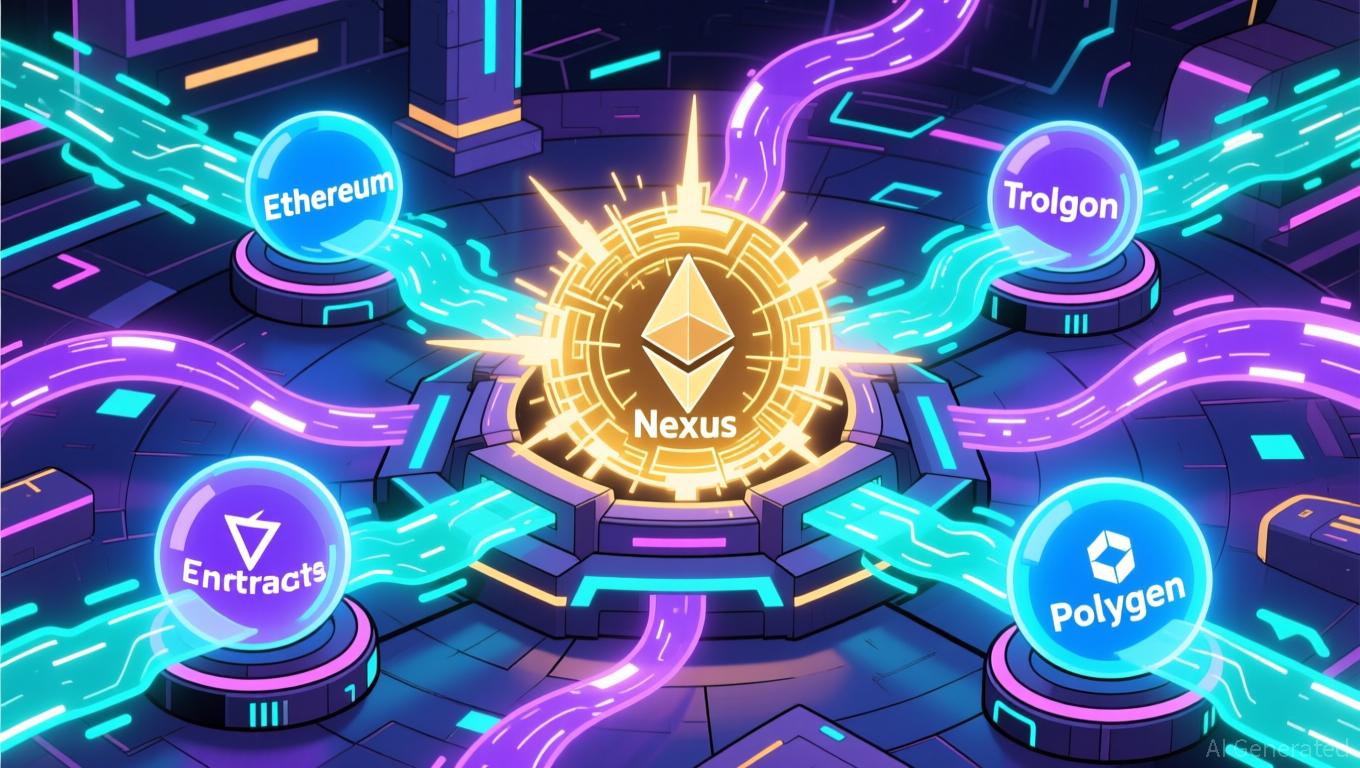Vitalik Buterin's Latest Support for ZK Technology and What It Means for the Cryptocurrency Industry
- Vitalik Buterin is driving a blockchain shift via ZK tech, enhancing Ethereum's scalability and privacy. - ZK infrastructure's $28B TVL surge highlights projects like zkSync Era and StarkNet boosting DeFi and gaming. - Investors target EVM-compatible ZK rollups and privacy toolkits, aligning with Ethereum's ZK roadmap.
The Rise of Zero-Knowledge Technology in Blockchain
The blockchain landscape is experiencing a significant transformation fueled by advancements in zero-knowledge (ZK) technology. Vitalik Buterin has become a central figure in this shift, championing the integration of ZK-based systems—including cutting-edge cryptography, privacy-focused tools, and scalable rollup solutions. His leadership has sparked increased activity in the market, establishing ZK as a foundational element in Ethereum’s ongoing development. For those looking to invest, this marks a pivotal moment: getting involved early in ZK infrastructure projects could lead to substantial gains as the sector evolves.
Buterin’s Blueprint: ZK at the Core of Ethereum’s Future
Looking ahead to 2025, Buterin’s plans emphasize a decisive move toward solutions centered on zero-knowledge proofs. He is pushing for innovations such as private account abstraction and advanced cryptographic methods like multi-party computation (MPC) and fully homomorphic encryption (FHE) to tackle Ethereum’s current limitations in scalability and privacy.
One major initiative is the overhaul of Ethereum’s modular exponentiation (modexp) precompile, aiming to lower the computational burden of ZK operations. This change is expected to enhance the speed and efficiency of zero-knowledge rollups and EVM-compatible proofs. These are not minor updates, but rather fundamental changes that will align Ethereum’s structure with ZK-native principles, paving the way for new breakthroughs.
Market Momentum: ZK Infrastructure’s Rapid Expansion
The market has responded enthusiastically to Buterin’s vision. By 2025, ZK infrastructure has accumulated $28 billion in Total Value Locked (TVL), with notable contributions from projects such as zkSync Era, StarkNet, and Polygon zkEVM.
- zkSync Era processes more than 27 million transactions each month, significantly lowering costs for DeFi applications while increasing transaction throughput.
- StarkNet utilizes STARK proofs to support high-volume applications, including decentralized derivatives platforms like dYdX. Its design ensures both scalability and robust security for transactions.
- Polygon zkEVM is engineered for compatibility with EVM bytecode, allowing developers to deploy Solidity contracts with minimal changes and offering cost-effective solutions for blockchain gaming.

Beyond these established players, Zero Knowledge Proof (ZKP) introduces a new ZK-native framework built entirely from scratch. Although still in development, features like Proof Pods and an on-chain ICA auction system embody Buterin’s vision for fully ZK-based architectures. This project demonstrates the potential for early adopters to gain an edge in the emerging ZK-native infrastructure space, where innovation is still in its early stages.
Key Investment Areas in ZK Infrastructure
The intersection of Buterin’s advocacy and growing market adoption presents compelling opportunities for early investment in ZK infrastructure. Three main sectors stand out:
- EVM-Compatible Rollups: Projects such as zkSync Era and Polygon zkEVM are bridging Ethereum’s current ecosystem with the scalability benefits of ZK technology. Their retention of EVM compatibility while reducing transaction costs makes them essential for widespread adoption.
- Privacy Toolkits: The Kohaku toolkit, developed under Buterin’s guidance, integrates private transactions, secure key management, and risk-based controls. By allowing wallets to default to private transactions while staying compliant with regulations, Kohaku could become a foundational layer in the ZK technology stack, attracting a growing user base focused on privacy.
- ZK-Native Protocols: Early-stage projects like ZKP, which are designed with ZK logic from the outset, offer high-risk but potentially high-reward prospects. Their alignment with Buterin’s strategic direction ensures they remain at the forefront of technological progress, despite the challenges of untested models and technical complexity.
Potential Risks and Challenges
Investors should be aware of several risks, including the technical difficulties of scaling ZK proofs, regulatory uncertainties surrounding privacy technologies, and competition from other layer-2 solutions. For example, integrating Kohaku with existing privacy platforms like Railgun creates dependencies on external ecosystems. Likewise, ZKP’s innovative auction-based token distribution could encounter liquidity issues if adoption does not meet expectations.
Conclusion: A Transformative Era for Blockchain Infrastructure
Vitalik Buterin’s commitment to zero-knowledge technology signals a fundamental change in the direction of blockchain development. By focusing on privacy, scalability, and advanced cryptography, he is laying the foundation for a new generation of decentralized infrastructure. For investors, this period offers a unique chance to support projects that not only align with Ethereum’s future but also have the potential to set new industry benchmarks. As both TVL and transaction volumes continue to climb, early investment in ZK infrastructure remains a strategic move for those aiming to participate in the next wave of blockchain innovation.
Disclaimer: The content of this article solely reflects the author's opinion and does not represent the platform in any capacity. This article is not intended to serve as a reference for making investment decisions.
You may also like
Investors Look for Stability Amid 2025 Meme Coin Craze
- 2025 crypto market sees renewed meme coin frenzy, led by $APEING's whitelist-driven presale and viral tokens like Pepe and Bonk . - Projects prioritize community engagement and structured participation to mitigate speculation risks while expanding into mainstream finance via ETPs. - Market analysis highlights $1.93B Pepe's price projections and Solana-based Bonk's Swiss ETP listing, signaling sector maturation amid regulatory uncertainty. - Analysts warn of volatility and speculative bubbles, urging inve

Breaking Down Blockchain Barriers: Avail's Nexus Brings Together Liquidity and Execution
- Avail's Nexus introduces a cross-chain infrastructure to unify liquidity and execution across major blockchain ecosystems, acting as Web3's "execution spine." - The platform uses intent-solver architecture to automate optimal execution paths, eliminating manual bridging and fragmented liquidity management. - It enables seamless user experiences and streamlined developer integration via SDKs, APIs, and modular tools across Ethereum , Polygon, and other chains. - Industry analysts highlight Nexus as a pote

Stellar News Today: U.S. Bank Introduces Stellar Stablecoin to Establish Benchmark for Regulated Digital Assets
- U.S. Bank tests Stellar-based stablecoin with PwC and SDF, joining traditional banks adopting blockchain for financial innovation. - Stellar's asset-freeze, transaction-reversal features and 99.99% uptime align with banking compliance needs like KYC protocols. - The pilot highlights Stellar's low-cost, rapid settlements (3-5 seconds) and institutional reliability, attracting major financial players. - The project aims to create a regulated, deposit-backed stablecoin alternative to USDT/USDC, potentially

Global postponements in crypto taxation highlight challenges in regulatory frameworks
- UK's 2025 Budget sparks global focus on crypto tax challenges amid fragmented regulations and delayed frameworks. - South Korea postpones crypto tax to 2027 due to unclear definitions, while Switzerland delays OECD CARF adoption until 2027. - OECD's CARF aims to automate cross-border crypto data exchange, with U.S. and South Korea aligning to combat offshore evasion. - UK prioritizes infrastructure spending over direct crypto regulation, highlighting tensions between economic growth and digital asset gov
